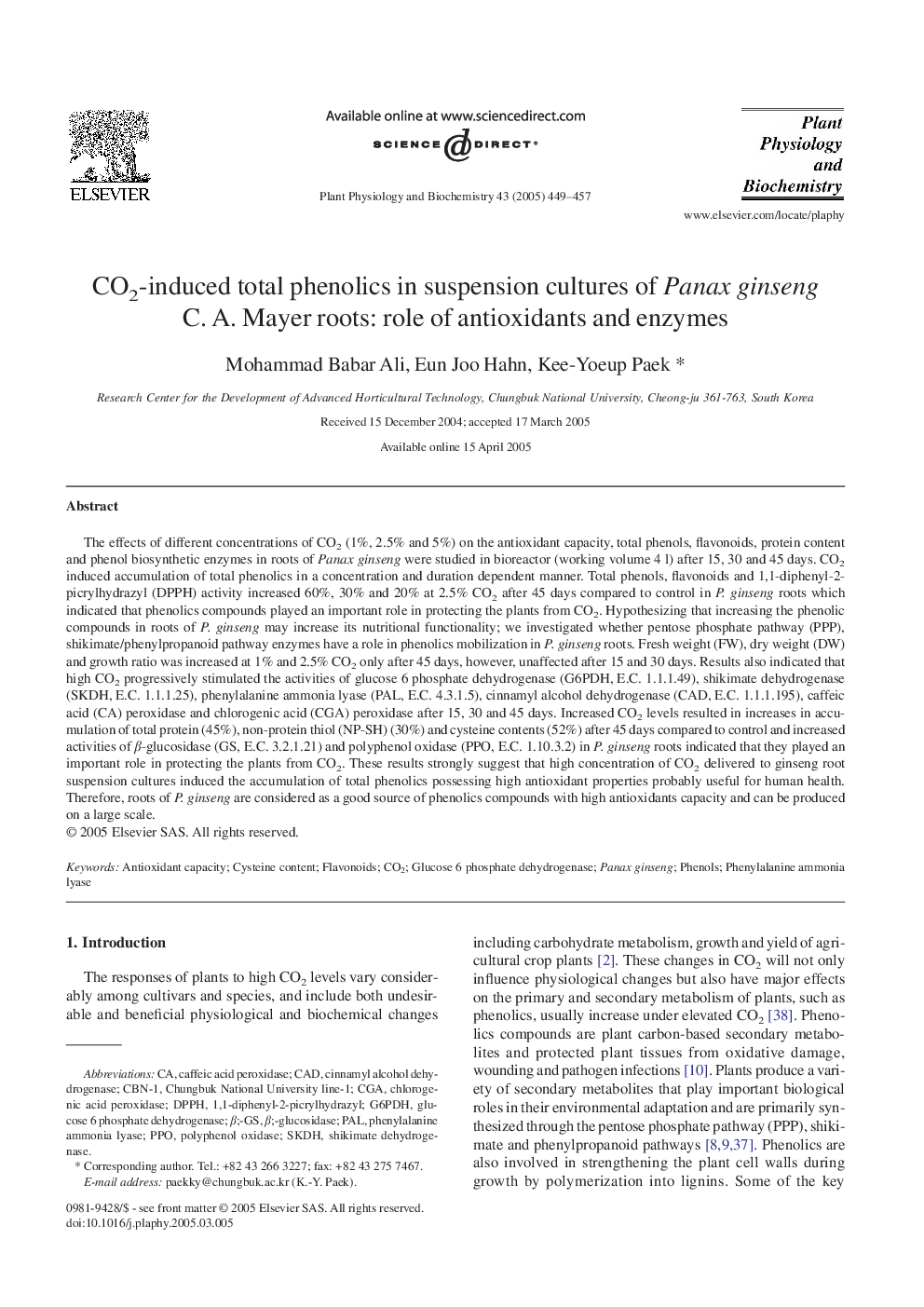| کد مقاله | کد نشریه | سال انتشار | مقاله انگلیسی | نسخه تمام متن |
|---|---|---|---|---|
| 10840142 | 1067575 | 2005 | 9 صفحه PDF | دانلود رایگان |
عنوان انگلیسی مقاله ISI
CO2-induced total phenolics in suspension cultures of Panax ginseng C. A. Mayer roots: role of antioxidants and enzymes
دانلود مقاله + سفارش ترجمه
دانلود مقاله ISI انگلیسی
رایگان برای ایرانیان
کلمات کلیدی
PPOSKDHG6PDHCGAPALDPPH1,1-diphenyl-2-picrylhydrazyl - 1،1-دیفنیل-2-پریکیل هیدرازیلPanax ginseng - جینسنگ PanaxCinnamyl alcohol dehydrogenase - سدیم هیدروژناز الکل سینامیلShikimate dehydrogenase - شیکیته دهیدروژنازCAD - طراحی به کمک رایانه یا کَدAntioxidant capacity - ظرفیت آنتی اکسیدانFlavonoids - فلاونوئیدهاPhenols - فنولPhenylalanine ammonia lyase - فنیل آلانین آمونیاک لیائازPolyphenol oxidase - پلی فنول اکسیدازCO2 - کربن دیاکسیدGlucose 6 phosphate dehydrogenase - گلوکز 6 فسفات دهیدروژناز
موضوعات مرتبط
علوم زیستی و بیوفناوری
علوم کشاورزی و بیولوژیک
دانش گیاه شناسی
پیش نمایش صفحه اول مقاله

چکیده انگلیسی
The effects of different concentrations of CO2 (1%, 2.5% and 5%) on the antioxidant capacity, total phenols, flavonoids, protein content and phenol biosynthetic enzymes in roots of Panax ginseng were studied in bioreactor (working volume 4 l) after 15, 30 and 45 days. CO2 induced accumulation of total phenolics in a concentration and duration dependent manner. Total phenols, flavonoids and 1,1-diphenyl-2-picrylhydrazyl (DPPH) activity increased 60%, 30% and 20% at 2.5% CO2 after 45 days compared to control in P. ginseng roots which indicated that phenolics compounds played an important role in protecting the plants from CO2. Hypothesizing that increasing the phenolic compounds in roots of P. ginseng may increase its nutritional functionality; we investigated whether pentose phosphate pathway (PPP), shikimate/phenylpropanoid pathway enzymes have a role in phenolics mobilization in P. ginseng roots. Fresh weight (FW), dry weight (DW) and growth ratio was increased at 1% and 2.5% CO2 only after 45 days, however, unaffected after 15 and 30 days. Results also indicated that high CO2 progressively stimulated the activities of glucose 6 phosphate dehydrogenase (G6PDH, E.C. 1.1.1.49), shikimate dehydrogenase (SKDH, E.C. 1.1.1.25), phenylalanine ammonia lyase (PAL, E.C. 4.3.1.5), cinnamyl alcohol dehydrogenase (CAD, E.C. 1.1.1.195), caffeic acid (CA) peroxidase and chlorogenic acid (CGA) peroxidase after 15, 30 and 45 days. Increased CO2 levels resulted in increases in accumulation of total protein (45%), non-protein thiol (NP-SH) (30%) and cysteine contents (52%) after 45 days compared to control and increased activities of β-glucosidase (GS, E.C. 3.2.1.21) and polyphenol oxidase (PPO, E.C. 1.10.3.2) in P. ginseng roots indicated that they played an important role in protecting the plants from CO2. These results strongly suggest that high concentration of CO2 delivered to ginseng root suspension cultures induced the accumulation of total phenolics possessing high antioxidant properties probably useful for human health. Therefore, roots of P. ginseng are considered as a good source of phenolics compounds with high antioxidants capacity and can be produced on a large scale.
ناشر
Database: Elsevier - ScienceDirect (ساینس دایرکت)
Journal: Plant Physiology and Biochemistry - Volume 43, Issue 5, May 2005, Pages 449-457
Journal: Plant Physiology and Biochemistry - Volume 43, Issue 5, May 2005, Pages 449-457
نویسندگان
Mohammad Babar Ali, Eun Joo Hahn, Kee-Yoeup Paek,